Restorative Poses
Practice Yoga Mindfully with Restorative Poses
Yoga is not just a physical exercise; it is a practice that connects the mind, body, and spirit. Mindful yoga practice involves being present in the moment, focusing on the breath, and listening to your body's needs. Incorporating restorative poses into your yoga routine can help you relax, reduce stress, and rejuvenate your mind and body.
Benefits of Mindful Yoga Practice
- Improves flexibility and strength
- Reduces stress and anxiety
- Enhances concentration and mindfulness
- Promotes relaxation and better sleep
- Boosts overall well-being
Restorative Poses for Relaxation
Restorative yoga poses are gentle, supported poses that allow the body to relax deeply. They help activate the parasympathetic nervous system, also known as the rest-and-digest response, which promotes relaxation and healing.
1. Child's Pose (Balasana)

Child's Pose gently stretches the hips, thighs, and ankles while calming the mind and relieving stress.
2. Legs Up the Wall Pose (Viparita Karani)

This restorative pose helps improve circulation, reduce swelling in the legs, and relax the nervous system.
3. Supported Bridge Pose

Supported Bridge Pose opens the chest, shoulders, and abdomen while calming the mind and reducing fatigue.
Tips for Mindful Yoga Practice
- Focus on your breath and stay present in each pose
- Listen to your body and avoid pushing yourself too far
- Use props like blocks, bolsters, and blankets for added support
- Practice gratitude and self-compassion during your yoga session
- End your practice with a relaxation pose or meditation
Integrating restorative poses into your yoga practice can help you cultivate a sense of inner peace, balance, and well-being. Remember to approach your practice with mindfulness, kindness, and self-awareness to experience the full benefits of yoga on and off the mat.
Start your mindful yoga journey today and embrace the healing power of restorative poses!
